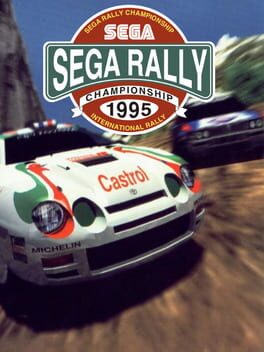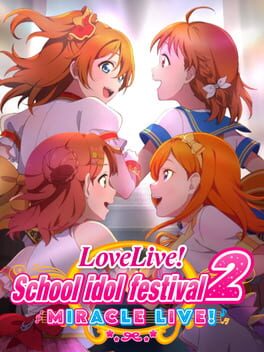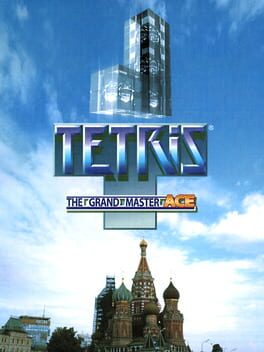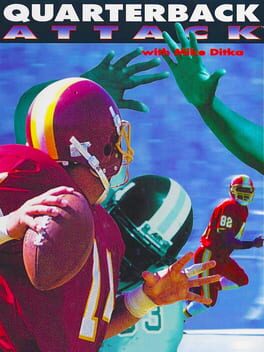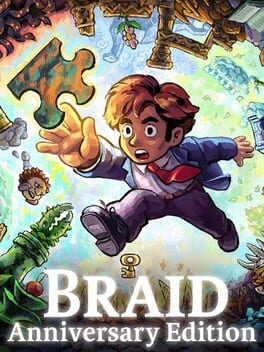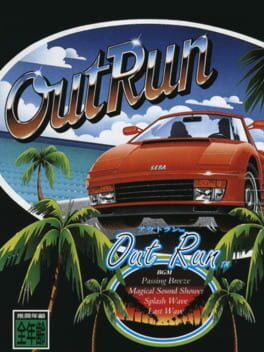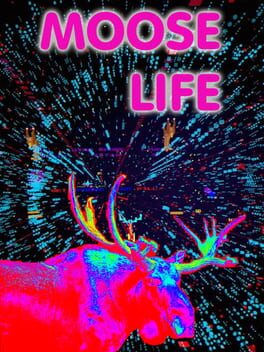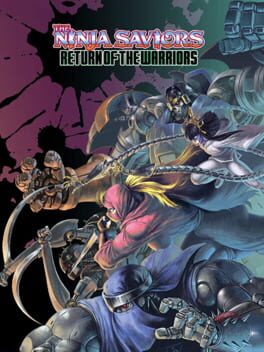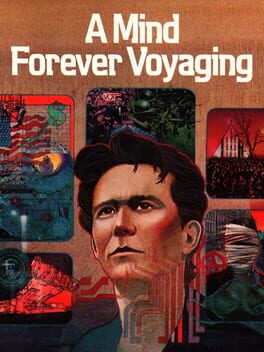BjgBug
19 Reviews liked by BjgBug
Beneath a Steel Sky
1994
complaining about the track count in this game is like being handed 3 gold bars by a total stranger and responding, "what, only 3?!". i understand that a simple kart racer's replay value is wholly dependent on track quantity and variety, but this ain't no simple kart racer. this is sega rally championship, bitch.
fun fact: the first time i ever operated a car, i said out loud, "holy shit, this is just like sega rally championship!"
addendum: the more racing games i play, the more i appreciate saturn src's handling. with as little as two buttons and a d-pad, you are given both the precision and expressiveness of the best arcade racers played on a full machine. who knew that weakly saturn could power such a finely-tuned physics engine, one that will both brutally punish you for the slightest mistakes and allow you to pull off some insane-o shit across a variety of kinesthetically-distinct terrains? understandably, 90% of people prefer the more capable psx and n64, but it's the fact that the saturn was such a technical dumpster fire which makes me love its library that much more. every good game counts.
i didn't mention in the old version of this review, but i find the aesthetics here severely lacking in comparison to the other sega arcade racing classics. aesthetics are often more important to me than gameplay. yet i sit here with a glowing review and a 4-star rating because the Toyota Celica GT-Four and Lancia Delta, these beautiful bastards, feel so amazing that they single-handedly changed me into a racing game fiend. sega 4 life
fun fact: the first time i ever operated a car, i said out loud, "holy shit, this is just like sega rally championship!"
addendum: the more racing games i play, the more i appreciate saturn src's handling. with as little as two buttons and a d-pad, you are given both the precision and expressiveness of the best arcade racers played on a full machine. who knew that weakly saturn could power such a finely-tuned physics engine, one that will both brutally punish you for the slightest mistakes and allow you to pull off some insane-o shit across a variety of kinesthetically-distinct terrains? understandably, 90% of people prefer the more capable psx and n64, but it's the fact that the saturn was such a technical dumpster fire which makes me love its library that much more. every good game counts.
i didn't mention in the old version of this review, but i find the aesthetics here severely lacking in comparison to the other sega arcade racing classics. aesthetics are often more important to me than gameplay. yet i sit here with a glowing review and a 4-star rating because the Toyota Celica GT-Four and Lancia Delta, these beautiful bastards, feel so amazing that they single-handedly changed me into a racing game fiend. sega 4 life
What a complete joke of a game from start to finish. I had so so SO much hope for this game considering they had to kill TWO games for it and this was one of the biggest disappointments ever.
I'll start with the good things because it's going to be very short and sweet. The gameplay definitely felt better than ever. It was apparently pretty messy on launch in Japan but for the global launch they seem to have gotten everything together very well. The amount of customization you can do for the live shows blow the original game out of the water so it was really fun being able to relive the gameplay from the original game in its ideal form. The new cards are absolutely gorgeous and oh my GOD the Daily Life shorts are pure dopamine. There's also a decent chunk of goodies in the app while you're not doing shows (I definitely spent a LOT of time going through all the song descriptions, whoever wrote those was probably the most passionate person on the entire team). The rehearsal feature was SUPER nice, as was being able to restart songs without having to waste LP, despite that it encouraged me to retry spam quite a bit lol.
Aaaaand unfortunately, that's where the positives end. SIF2 is unacceptably buggy and unfinished for how long it's been out in Japan and how long they had to work on it beforehand. Buttons that don't work, text that is left completely untranslated, even entire features that just straight up did not work (including ones that already worked in the Japanese version!). While events were running, the game would legitimately just completely break at every strike of the hour, leaving the game inoperable for around 15 minutes each HOUR. Not only that, they repeatedly DENIED it through bug reports and emails to support. It really just shows that the team did not care whatsoever about the game and just wanted to make as much money as possible before shutdown.
Aside from what I described in the intro, this game is just objectively inferior to the original, which released over a DECADE ago. The game has ZERO story content aside from the short introduction with each group and the 5-part Daily Life shorts. Any form of side-story was also removed and replaced by the messaging feature, where you can engage in short text messages with different members. Cool in concept but in practice was very obviously just a way to do less work. The gacha is much more expensive, there's less to do in the app, I could go on and on.
Events are a complete disaster as well. Results take a full two days to come out when it took less than an hour in the original. Complete lack of anti-cheat leaving event leaderboards FULL of obvious cheaters, which don't even get removed after the two days of results processing. One event shortly after release would give rewards that expire immediately upon collecting them. The complete lack of playerbase made the events feel so hollow and empty. I could consistently get top 1k on the events just by playing for a couple mins every day so there was no incentive whatsoever to actually put effort and time into getting into the higher tiers like the original had (which, to be fair, I wouldn't want to regardless on this piece of garbage).
I am so utterly disappointed and Bushiroad should be embarrassed they ever shipped this abomination of a game. This was most likely our last chance for official μ's content, so it's depressing to see it go out with such a whimper. The Love Live franchise is one of the most important things ever to me and to see it treated with such disrespect is just plain upsetting to see. Here's hoping we can somehow get a SIF3 managed by literally anybody but Bushiroad but if not, guess we're stuck with what, Link Like? The Yohane games? After School Activity? I don't know.
You're a disgrace, Bushiroad.
I'll start with the good things because it's going to be very short and sweet. The gameplay definitely felt better than ever. It was apparently pretty messy on launch in Japan but for the global launch they seem to have gotten everything together very well. The amount of customization you can do for the live shows blow the original game out of the water so it was really fun being able to relive the gameplay from the original game in its ideal form. The new cards are absolutely gorgeous and oh my GOD the Daily Life shorts are pure dopamine. There's also a decent chunk of goodies in the app while you're not doing shows (I definitely spent a LOT of time going through all the song descriptions, whoever wrote those was probably the most passionate person on the entire team). The rehearsal feature was SUPER nice, as was being able to restart songs without having to waste LP, despite that it encouraged me to retry spam quite a bit lol.
Aaaaand unfortunately, that's where the positives end. SIF2 is unacceptably buggy and unfinished for how long it's been out in Japan and how long they had to work on it beforehand. Buttons that don't work, text that is left completely untranslated, even entire features that just straight up did not work (including ones that already worked in the Japanese version!). While events were running, the game would legitimately just completely break at every strike of the hour, leaving the game inoperable for around 15 minutes each HOUR. Not only that, they repeatedly DENIED it through bug reports and emails to support. It really just shows that the team did not care whatsoever about the game and just wanted to make as much money as possible before shutdown.
Aside from what I described in the intro, this game is just objectively inferior to the original, which released over a DECADE ago. The game has ZERO story content aside from the short introduction with each group and the 5-part Daily Life shorts. Any form of side-story was also removed and replaced by the messaging feature, where you can engage in short text messages with different members. Cool in concept but in practice was very obviously just a way to do less work. The gacha is much more expensive, there's less to do in the app, I could go on and on.
Events are a complete disaster as well. Results take a full two days to come out when it took less than an hour in the original. Complete lack of anti-cheat leaving event leaderboards FULL of obvious cheaters, which don't even get removed after the two days of results processing. One event shortly after release would give rewards that expire immediately upon collecting them. The complete lack of playerbase made the events feel so hollow and empty. I could consistently get top 1k on the events just by playing for a couple mins every day so there was no incentive whatsoever to actually put effort and time into getting into the higher tiers like the original had (which, to be fair, I wouldn't want to regardless on this piece of garbage).
I am so utterly disappointed and Bushiroad should be embarrassed they ever shipped this abomination of a game. This was most likely our last chance for official μ's content, so it's depressing to see it go out with such a whimper. The Love Live franchise is one of the most important things ever to me and to see it treated with such disrespect is just plain upsetting to see. Here's hoping we can somehow get a SIF3 managed by literally anybody but Bushiroad but if not, guess we're stuck with what, Link Like? The Yohane games? After School Activity? I don't know.
You're a disgrace, Bushiroad.
While I know that this game is considered a downgrade for a lot of TGM fans, this is great for someone like me who's on the more casual side of Tetris but looking for a greater challenge than offered by most games.
Greatly enjoyed my time with this one and will be dipping in and out as I feel like it. Tetris + speed feat. satisfying sound effects = dopamine overload.
Note: Finished all modes I could without an XBL Gold account (can't hook mine up to this 360), so while I could count it as "Completed", I didn't feel I'd quite met the completion here.
Greatly enjoyed my time with this one and will be dipping in and out as I feel like it. Tetris + speed feat. satisfying sound effects = dopamine overload.
Note: Finished all modes I could without an XBL Gold account (can't hook mine up to this 360), so while I could count it as "Completed", I didn't feel I'd quite met the completion here.
NFL content seems to be the most unfun stuff on planet earth, to the point that they managed to make a FMV game feel miserable to play, watch, and think about. To add some grace to whatever is happening in this game, which I advise against looking for as even if you think its gonna be "so bad its good" it really won't, have 121 totally funny american football jokes lets go:
1. Why did the football coach go to the bank?
To get his quarter back.
2. What do football players wear on Halloween?
Face masks!
3. Which two football teams played in the Pirate Super Bowl?
The Seahawks and the Buccaneers.
4. What kind of tea do football players drink?
Penaltea.
5. Why was the tiny ghost asked to join the football team?
They needed a little team spirit.
6. Why didn’t the dog want to play football?
It was a boxer.
7. Which football player wears the biggest helmet?
The one with the biggest head.
8. Where do football players dance?
At a foot ball!
9. What do football players do when they get overheated?
They get closer to some of the fans.
10. Why did the poor quarterback have his receivers cross at mid-field?
He was trying to make ends meet
11. Why didn’t the skeleton play football?
His heart wasn’t in it
12. Why are centipedes not allowed to play on bug football teams?
It takes too long to put their cleats on
13. What did the football coach say to the broken candy machine?
Give me my quarterback!
14. Where do football players go when they need a new uniform?
New Jersey.
15. How is a football referee like an angry chicken?
They both have fowl mouths.
16. When should football players wear armor?
When they play knight games.
17. Which state should the Tampa Bay Buccaneers move to?
Arrrrrrrrrkansas.
18. Why did Cinderella get kicked off the football team?
Because she kept running away from the ball!
19. Why did the football quit the team?
It was tired of being kicked around!
20. What did the receiver say to the football?
Catch you later.
21. Why was Cinderella such a poor football player?
Her coach was a pumpkin.
21. What happens to football players who go blind?
They become referees.
22. Which football player wears the biggest helmet?
The one with the biggest head.
23. What does a Minnesota Vikings fan do when their team has won the Super Bowl?
They turn off the PlayStation 4.
24. Where do hungry football players play?
In the Supper Bowl.
25. What do you call a lineman’s kid?
A chip off the old blocker.
26. What did the football say to the punter?
I get a kick out of you.
27. Which insect doesn’t play well in football?
The fumble bee.
28. Which football game do cats like to watch?
The Goldfish Bowl.
29. What do centers wear on their feet?
Hiking shoes.
30. Why was the tiny ghost asked to join the football team?
They needed a little team spirit.
31. Who is the leader of the Tampa Bay Buccaneers?
Captain Hook!
32. Why shouldn’t you play football in the jungle?
There are too many cheetahs!
33. Why did the football player bring string to the game?
So he could tie the score.
34. Why couldn’t the all-star football player listen to music?
Because he broke all the records.
35. What do you call a person who walks back and forth screaming one minute, then sits down weeping uncontrollably the next?
A football coach.
36. What football play should you be suspicious of?
The quarterback sneak.
37. What’s the difference between a quarterback and a baby?
One takes the snap, the other takes a nap.
38. What did the football coach say to the broken vending machine?
“Give me my quarter back!”
39. How is losing money in a payphone like a football game?
If you don’t get the quarter back, you hit the receiver!
40. How do you stop squirrels playing football in the garden?
Hide the ball; it drives them nuts!
41. Knock, knock?
Who is there? August. August Who? A gusta go back to football practice!
42. What did the college football say to the punter?
“I get a kick out of you.”
43. Did you hear about the football player who asked his coach to flood the field so he could go in as a sub?
44. What kind of ends do you find in libraries?
Book ends.
45. Which player is the easiest target to hit with the football?
The wide receiver.
46. Who are the happiest people at the football game?
The cheerleaders.
47. Why are college football stadiums always cool?
Because they’re full of fans.
48. Why was the skeleton always left out of the football game?
Because he had no body to go with.
49. What did the mummy football coach say at the end of practice?
“Let’s wrap this up!”
50. What would you get if you crossed a football player and the Invisible Man?
Football like no one has ever seen.
51. What do a bad football team and possums have in common?
Both play dead at home and get killed on the road!
52. What do you call 53 millionaires around a TV watching the Super Bowl?
The Dallas Cowboys.
53. When is a football player like a judge?
When he sits on the bench.
54. Why is someone who borrows money but does not pay it all back like a football player?
Because sometimes he gives you a quarter back and sometimes a half back.
55. What’s the difference between the poor, inconsistent football team, and a dollar bill?
You can still get four quarters out of a dollar bill.
56. What do biology majors wear on their heads when playing football?
Helminth.
57. Where do quarterbacks go when they get old?
Out to pass-ture.
58. Did you hear that some college football teams don’t have a website?
They can’t string three “Ws” together.
59. What is harder to catch the faster you run?
Your breath!
60. Why do ballet dancers make such good NFL kickers?
They know how to split the uprights!
61. Which football player wears the biggest cleats?
The one with the biggest feet!
62. Where is a ghost’s favorite spot on a football field
Under the ghoul posts!
63. What is it called when a dinosaur gets a touchdown?
A dino-score.
64. What runs around a football field but never moves?
A fence.
65. What did the bumble bee running back say after getting a touchdown?
Hive scored.
66. Why did the chicken get ejected from the football game?
For persistent fowl play.
67. What are successful kickers always trying to do?
Reach goals.
68. Why can’t Tampa Bay Buccaneers play golf?
They always hook the ball.
69. Knock, knock.
Who’s there? Tess me. Tess me who? Tess me the football!
70. Why couldn’t the defensive football player pass his test in school?
He was a tackling dummy.
71. Why couldn’t the all-star football player listen to music?
Because he broke all the records.
72. What do you call a person who walks back and forth screaming one minute, then sits down weeping uncontrollably the next?
A football coach.
73. Why can’t the Detroit Lions player get into his own driveway?
Someone painted an endzone on it.
74. Why can’t you play football with pigs?
They hog the ball.
75. How are scrambled eggs like a losing football team?
They’ve both been beaten.
76. Which football team has the coolest helmets?
The one with the most fans.
77. Knock, knock.
Who’s there? Uriah. Uriah who? Keep Uriah on the ball.
78. Why is it always warmer after a football game?
All the fans have left.
79. How do you get out of a locked car if you have nothing but a football?
Unlock the door and pull the handle.
80. I was wondering why the football was getting bigger. Then it hit me.
81. Why was the pig ejected from the game?
For playing dirty.
82. Did you hear about the fumbled exorcism?
The guy retained possession!
83. Why should you never go back in time to alter the outcome of a football game?
Then you’ll be charged with interference.
84. Why don’t quarterbacks share puns when playing?
Because they produce audible groans!
85. What stat do the Miami Dolphins lead every single year?
All porpoise yardage!
86. What do you call it when a football player suffers a career-ending injury in his last game before retirement?
Gridirony!
87. What do you do if a running back swallows the football?
You have to get him to cough it up.
88. Why was McGruff the Crime Dog ejected from the football game?
He was called for unnecessary gruffness!
89. Did you hear that Notre Dame gave up four interceptions last week?
Knute Rockne would turnover in his grave.
90. What do you call 20 Vikings fans in the basement?
A whine cellar.
91. Why did the quarterback suddenly walk off the field?
The coach told him to take a hike!
92. What happened when the football coach’s dog ran onto the field during a game?
He got called for ineligible retriever downfield.
93. Why did the football referee have trouble measuring the first down?
Someone was yanking his chain.
94. Did you hear about the Heisman Trophy candidate who falsified his rushing stats?
The yards were stacked in his favor.
95. Why did the kicker finally decide to marry his high school sweetheart?
She was a fair catch.
96. What’s the difference between a punter and punster?
A punster gets his kicks with bad puns like these!
97. How did Scrooge end up with the football?
The ghost of Christmas passed.
98. Did you hear about the football field NASA built on the moon?
They used astroturf.
99. Which are the best animals at football?
A score-pion.
100. Where do football players go shopping in the offseason?
The tackle shop.
101. How do football players stay cool?
By standing close to the fans.
102. What happened to the joke that Tom Brady told his receivers?
It went over their heads.
103. My wife left me because she says I’m too obsessed with football.
Oh well, we had five good seasons together.
104. Why did the football player cross the field?
To get to the other sideline.
105. 8 p.m.: I get a text from my girlfriend that says, “Me or football?!”
11 p.m.: I text back, “You, of course.”
106. Where do Jedi play football?
On the force field.
107. What do you call a boat full of polite football players?
A good sportsman-ship.
108. College football is introducing the Rosary Bowl…
Every play is a Hail Mary.
109. Two football players are in a bar.
One walks up to the other and says, “Hey, wanna shot?” The other says, “I’ll pass.”
110. Why is the football stadium so windy?
Because of all the fans.
111. Someday, I want to make an edgy football joke on Facebook.
It’s my goal post.
112. The last time I played tackle football without pads, I broke three ribs and a collar bone.
Fortunately, none of them were mine.
113. What did the football player say to the flight attendant?
“Put me in coach!”
114. Why do coaches like punters?
Because punters always put their best foot forward.
115. What football player has very strong legs and builds houses?
A car-punter.
116. What does JETS stand for?
Just End The Season.
117. How many Jets fans does it take to change a light bulb?
None, they are happy living in New England’s shadow!
118. What do you call a New York Jet with a Super Bowl ring?
A thief.
119. Want to hear a Chicago Bears joke?
Jay Cutler.
120. What is the difference between a Los Angeles Rams fan and a baby?
A baby will stop whining after a while.
121. What do you call 53 millionaires around a TV watching the Super Bowl?
The New Orleans Saints.
1. Why did the football coach go to the bank?
To get his quarter back.
2. What do football players wear on Halloween?
Face masks!
3. Which two football teams played in the Pirate Super Bowl?
The Seahawks and the Buccaneers.
4. What kind of tea do football players drink?
Penaltea.
5. Why was the tiny ghost asked to join the football team?
They needed a little team spirit.
6. Why didn’t the dog want to play football?
It was a boxer.
7. Which football player wears the biggest helmet?
The one with the biggest head.
8. Where do football players dance?
At a foot ball!
9. What do football players do when they get overheated?
They get closer to some of the fans.
10. Why did the poor quarterback have his receivers cross at mid-field?
He was trying to make ends meet
11. Why didn’t the skeleton play football?
His heart wasn’t in it
12. Why are centipedes not allowed to play on bug football teams?
It takes too long to put their cleats on
13. What did the football coach say to the broken candy machine?
Give me my quarterback!
14. Where do football players go when they need a new uniform?
New Jersey.
15. How is a football referee like an angry chicken?
They both have fowl mouths.
16. When should football players wear armor?
When they play knight games.
17. Which state should the Tampa Bay Buccaneers move to?
Arrrrrrrrrkansas.
18. Why did Cinderella get kicked off the football team?
Because she kept running away from the ball!
19. Why did the football quit the team?
It was tired of being kicked around!
20. What did the receiver say to the football?
Catch you later.
21. Why was Cinderella such a poor football player?
Her coach was a pumpkin.
21. What happens to football players who go blind?
They become referees.
22. Which football player wears the biggest helmet?
The one with the biggest head.
23. What does a Minnesota Vikings fan do when their team has won the Super Bowl?
They turn off the PlayStation 4.
24. Where do hungry football players play?
In the Supper Bowl.
25. What do you call a lineman’s kid?
A chip off the old blocker.
26. What did the football say to the punter?
I get a kick out of you.
27. Which insect doesn’t play well in football?
The fumble bee.
28. Which football game do cats like to watch?
The Goldfish Bowl.
29. What do centers wear on their feet?
Hiking shoes.
30. Why was the tiny ghost asked to join the football team?
They needed a little team spirit.
31. Who is the leader of the Tampa Bay Buccaneers?
Captain Hook!
32. Why shouldn’t you play football in the jungle?
There are too many cheetahs!
33. Why did the football player bring string to the game?
So he could tie the score.
34. Why couldn’t the all-star football player listen to music?
Because he broke all the records.
35. What do you call a person who walks back and forth screaming one minute, then sits down weeping uncontrollably the next?
A football coach.
36. What football play should you be suspicious of?
The quarterback sneak.
37. What’s the difference between a quarterback and a baby?
One takes the snap, the other takes a nap.
38. What did the football coach say to the broken vending machine?
“Give me my quarter back!”
39. How is losing money in a payphone like a football game?
If you don’t get the quarter back, you hit the receiver!
40. How do you stop squirrels playing football in the garden?
Hide the ball; it drives them nuts!
41. Knock, knock?
Who is there? August. August Who? A gusta go back to football practice!
42. What did the college football say to the punter?
“I get a kick out of you.”
43. Did you hear about the football player who asked his coach to flood the field so he could go in as a sub?
44. What kind of ends do you find in libraries?
Book ends.
45. Which player is the easiest target to hit with the football?
The wide receiver.
46. Who are the happiest people at the football game?
The cheerleaders.
47. Why are college football stadiums always cool?
Because they’re full of fans.
48. Why was the skeleton always left out of the football game?
Because he had no body to go with.
49. What did the mummy football coach say at the end of practice?
“Let’s wrap this up!”
50. What would you get if you crossed a football player and the Invisible Man?
Football like no one has ever seen.
51. What do a bad football team and possums have in common?
Both play dead at home and get killed on the road!
52. What do you call 53 millionaires around a TV watching the Super Bowl?
The Dallas Cowboys.
53. When is a football player like a judge?
When he sits on the bench.
54. Why is someone who borrows money but does not pay it all back like a football player?
Because sometimes he gives you a quarter back and sometimes a half back.
55. What’s the difference between the poor, inconsistent football team, and a dollar bill?
You can still get four quarters out of a dollar bill.
56. What do biology majors wear on their heads when playing football?
Helminth.
57. Where do quarterbacks go when they get old?
Out to pass-ture.
58. Did you hear that some college football teams don’t have a website?
They can’t string three “Ws” together.
59. What is harder to catch the faster you run?
Your breath!
60. Why do ballet dancers make such good NFL kickers?
They know how to split the uprights!
61. Which football player wears the biggest cleats?
The one with the biggest feet!
62. Where is a ghost’s favorite spot on a football field
Under the ghoul posts!
63. What is it called when a dinosaur gets a touchdown?
A dino-score.
64. What runs around a football field but never moves?
A fence.
65. What did the bumble bee running back say after getting a touchdown?
Hive scored.
66. Why did the chicken get ejected from the football game?
For persistent fowl play.
67. What are successful kickers always trying to do?
Reach goals.
68. Why can’t Tampa Bay Buccaneers play golf?
They always hook the ball.
69. Knock, knock.
Who’s there? Tess me. Tess me who? Tess me the football!
70. Why couldn’t the defensive football player pass his test in school?
He was a tackling dummy.
71. Why couldn’t the all-star football player listen to music?
Because he broke all the records.
72. What do you call a person who walks back and forth screaming one minute, then sits down weeping uncontrollably the next?
A football coach.
73. Why can’t the Detroit Lions player get into his own driveway?
Someone painted an endzone on it.
74. Why can’t you play football with pigs?
They hog the ball.
75. How are scrambled eggs like a losing football team?
They’ve both been beaten.
76. Which football team has the coolest helmets?
The one with the most fans.
77. Knock, knock.
Who’s there? Uriah. Uriah who? Keep Uriah on the ball.
78. Why is it always warmer after a football game?
All the fans have left.
79. How do you get out of a locked car if you have nothing but a football?
Unlock the door and pull the handle.
80. I was wondering why the football was getting bigger. Then it hit me.
81. Why was the pig ejected from the game?
For playing dirty.
82. Did you hear about the fumbled exorcism?
The guy retained possession!
83. Why should you never go back in time to alter the outcome of a football game?
Then you’ll be charged with interference.
84. Why don’t quarterbacks share puns when playing?
Because they produce audible groans!
85. What stat do the Miami Dolphins lead every single year?
All porpoise yardage!
86. What do you call it when a football player suffers a career-ending injury in his last game before retirement?
Gridirony!
87. What do you do if a running back swallows the football?
You have to get him to cough it up.
88. Why was McGruff the Crime Dog ejected from the football game?
He was called for unnecessary gruffness!
89. Did you hear that Notre Dame gave up four interceptions last week?
Knute Rockne would turnover in his grave.
90. What do you call 20 Vikings fans in the basement?
A whine cellar.
91. Why did the quarterback suddenly walk off the field?
The coach told him to take a hike!
92. What happened when the football coach’s dog ran onto the field during a game?
He got called for ineligible retriever downfield.
93. Why did the football referee have trouble measuring the first down?
Someone was yanking his chain.
94. Did you hear about the Heisman Trophy candidate who falsified his rushing stats?
The yards were stacked in his favor.
95. Why did the kicker finally decide to marry his high school sweetheart?
She was a fair catch.
96. What’s the difference between a punter and punster?
A punster gets his kicks with bad puns like these!
97. How did Scrooge end up with the football?
The ghost of Christmas passed.
98. Did you hear about the football field NASA built on the moon?
They used astroturf.
99. Which are the best animals at football?
A score-pion.
100. Where do football players go shopping in the offseason?
The tackle shop.
101. How do football players stay cool?
By standing close to the fans.
102. What happened to the joke that Tom Brady told his receivers?
It went over their heads.
103. My wife left me because she says I’m too obsessed with football.
Oh well, we had five good seasons together.
104. Why did the football player cross the field?
To get to the other sideline.
105. 8 p.m.: I get a text from my girlfriend that says, “Me or football?!”
11 p.m.: I text back, “You, of course.”
106. Where do Jedi play football?
On the force field.
107. What do you call a boat full of polite football players?
A good sportsman-ship.
108. College football is introducing the Rosary Bowl…
Every play is a Hail Mary.
109. Two football players are in a bar.
One walks up to the other and says, “Hey, wanna shot?” The other says, “I’ll pass.”
110. Why is the football stadium so windy?
Because of all the fans.
111. Someday, I want to make an edgy football joke on Facebook.
It’s my goal post.
112. The last time I played tackle football without pads, I broke three ribs and a collar bone.
Fortunately, none of them were mine.
113. What did the football player say to the flight attendant?
“Put me in coach!”
114. Why do coaches like punters?
Because punters always put their best foot forward.
115. What football player has very strong legs and builds houses?
A car-punter.
116. What does JETS stand for?
Just End The Season.
117. How many Jets fans does it take to change a light bulb?
None, they are happy living in New England’s shadow!
118. What do you call a New York Jet with a Super Bowl ring?
A thief.
119. Want to hear a Chicago Bears joke?
Jay Cutler.
120. What is the difference between a Los Angeles Rams fan and a baby?
A baby will stop whining after a while.
121. What do you call 53 millionaires around a TV watching the Super Bowl?
The New Orleans Saints.
Kaze no Notam
1997
'There was an old Man of the Hague, whose ideas were excessively vague; he built a balloon, to examine the moon, that deluded Old Man of the Hague.'
– Edward Lear, A Book of Nonsense, 1846.
Played during the Backloggd’s Game of the Week (22nd Aug. – 28th Aug., 2023).
After his cycles of paintings on family and parties, dedicated to the study of interpersonal relationships, Michael Andrew spent several years developing a very refined meditation on the theme of air. He called this series 'Lights', which consists of a series of landscapes over which a hot air balloon flies. It hovers over the English countryside, over a river, through a city lit by the glow of the night, and so many other places before finally arriving at the sea. Lights VII: A Shadow (1974) is an ecstatic, dizzying work. The composition is divided between the sand, the sea and the sky, while the green shadow of the balloon stretches across the lower part of the canvas. Andrew's use of acrylics renders this landscape seemingly abstract, making it look sunburnt, like an old photograph.
For Andrew, the balloon represents the ego, and each painting is a way of pursuing inner meditation through exposure to the sensory world: 'the balloon was a metaphor for the self as it dispenses with the ego, gradually attaining spiritual enlightenment in the process. The balloon is thus present in the first three paintings in the cycle but absent from the next three. In the seventh and last painting only its shadow is represented' [1]. Andrew's contemplation is rooted in his singular relationship with the world, steeped in Zen philosophy and fascinated by the scientific advances of the twentieth century. To some extent, his 'Lights' series retains some of the realist features of his formative years.
Detchibe has explored the ways in which Hiroshi Nagai's work shapes a situated perception of the 1980s: it is necessary to correlate these ideas with the declinist discourse that haunted the Lost Decades following the collapse of the Japanese economic bubble at the end of the 1980s. Gradually, the positive valence attached to companies and work was eroded by at least three factors perceived by Japanese society and highlighted by the media: a relaxation of labour laws that allowed companies to employ part-time workers, leading to a sense of 'unemployment within the company' (shanai shitsugyo); critical difficulties for young people to enter the labour market; and the collapse of the myth of social equality with the disappearance of the middle class of office workers [2]. This frustration was clearly expressed by Artdink with the release of Aquanaut no Kyūjitsu (1995), which follows a burnt-out oceanographer who tries to reconnect with the environment by exploring the sea with a deliberately meditative approach.
Kaze no NOTAM also suggests a return to a certain serenity, but with a focus on contemplation rather than exploration. The player is invited to fly over different environments at different times of day, accompanied by a soundtrack that echoes the city-pop aesthetic that was in decline at the time. Kaze no NOTAM recontextualises inactivity, turning it into an opportunity for introspection, as the balloon is subject to the uncertainties of air currents, without the possibility of changing its course in detail. For workers, the unemployed or young people at a loss for meaning, the title suggests taking the time to question the reasons for existence and the value of time, conjuring up an optimistic view of a golden age recently lost: the only thing that counts is the present. Among the most striking moments in Kaze no NOTAM are some breathtaking vistas. Flying over a canopy bathed in the rays of the sinking sun has a special magic, as does seeing the northern lights overhanging the long skyscrapers in the glittering city heavens.
Like Andrew's 'Lights' series, the game offers semi-abstract scenes thanks to the sharp PS1 edges of the topography: the title leaves it to the player's imagination to fill in the picture. The variety of environments also allows for a real progression in the meditation exercise. It is surprising, however, that Kaze no NOTAM places such a strong emphasis on objectives; while Aquanaut no Kyūjitsu involved building a coral reef, finding artefacts was an underlying product of the organic exploration of the seabed. In Kaze no NOTAM, the mere selection of an objective in the main menu distorts the idea of an unfettered meditation, especially when certain modes impose a time limit. The player can, of course, ignore these targets – after all, the point is simply to fly. As Andrew, eternal dreamer of another world, noted when he borrowed a Rosalie Sorrels song for a tentative title of his paintings, Up Is A Nice Place To Be (1967), 'the best' even [3].
__________
[1] Richard Calvocoressi, 'Michael Andrews: Air', in Gagosian Quaterly, Spring 2017.
[2] Andrew Gordon, 'Making sense of the lost decades: Workplaces and schools, men and women, young and old, rich and poor', in Yoichi Funabashi, Barak Kushner (ed.), Examining Japan's Lost Decades, Routledge, London, 2015, pp. 77-100.
[3] Richard Calvocoressi, op. cit.
– Edward Lear, A Book of Nonsense, 1846.
Played during the Backloggd’s Game of the Week (22nd Aug. – 28th Aug., 2023).
After his cycles of paintings on family and parties, dedicated to the study of interpersonal relationships, Michael Andrew spent several years developing a very refined meditation on the theme of air. He called this series 'Lights', which consists of a series of landscapes over which a hot air balloon flies. It hovers over the English countryside, over a river, through a city lit by the glow of the night, and so many other places before finally arriving at the sea. Lights VII: A Shadow (1974) is an ecstatic, dizzying work. The composition is divided between the sand, the sea and the sky, while the green shadow of the balloon stretches across the lower part of the canvas. Andrew's use of acrylics renders this landscape seemingly abstract, making it look sunburnt, like an old photograph.
For Andrew, the balloon represents the ego, and each painting is a way of pursuing inner meditation through exposure to the sensory world: 'the balloon was a metaphor for the self as it dispenses with the ego, gradually attaining spiritual enlightenment in the process. The balloon is thus present in the first three paintings in the cycle but absent from the next three. In the seventh and last painting only its shadow is represented' [1]. Andrew's contemplation is rooted in his singular relationship with the world, steeped in Zen philosophy and fascinated by the scientific advances of the twentieth century. To some extent, his 'Lights' series retains some of the realist features of his formative years.
Detchibe has explored the ways in which Hiroshi Nagai's work shapes a situated perception of the 1980s: it is necessary to correlate these ideas with the declinist discourse that haunted the Lost Decades following the collapse of the Japanese economic bubble at the end of the 1980s. Gradually, the positive valence attached to companies and work was eroded by at least three factors perceived by Japanese society and highlighted by the media: a relaxation of labour laws that allowed companies to employ part-time workers, leading to a sense of 'unemployment within the company' (shanai shitsugyo); critical difficulties for young people to enter the labour market; and the collapse of the myth of social equality with the disappearance of the middle class of office workers [2]. This frustration was clearly expressed by Artdink with the release of Aquanaut no Kyūjitsu (1995), which follows a burnt-out oceanographer who tries to reconnect with the environment by exploring the sea with a deliberately meditative approach.
Kaze no NOTAM also suggests a return to a certain serenity, but with a focus on contemplation rather than exploration. The player is invited to fly over different environments at different times of day, accompanied by a soundtrack that echoes the city-pop aesthetic that was in decline at the time. Kaze no NOTAM recontextualises inactivity, turning it into an opportunity for introspection, as the balloon is subject to the uncertainties of air currents, without the possibility of changing its course in detail. For workers, the unemployed or young people at a loss for meaning, the title suggests taking the time to question the reasons for existence and the value of time, conjuring up an optimistic view of a golden age recently lost: the only thing that counts is the present. Among the most striking moments in Kaze no NOTAM are some breathtaking vistas. Flying over a canopy bathed in the rays of the sinking sun has a special magic, as does seeing the northern lights overhanging the long skyscrapers in the glittering city heavens.
Like Andrew's 'Lights' series, the game offers semi-abstract scenes thanks to the sharp PS1 edges of the topography: the title leaves it to the player's imagination to fill in the picture. The variety of environments also allows for a real progression in the meditation exercise. It is surprising, however, that Kaze no NOTAM places such a strong emphasis on objectives; while Aquanaut no Kyūjitsu involved building a coral reef, finding artefacts was an underlying product of the organic exploration of the seabed. In Kaze no NOTAM, the mere selection of an objective in the main menu distorts the idea of an unfettered meditation, especially when certain modes impose a time limit. The player can, of course, ignore these targets – after all, the point is simply to fly. As Andrew, eternal dreamer of another world, noted when he borrowed a Rosalie Sorrels song for a tentative title of his paintings, Up Is A Nice Place To Be (1967), 'the best' even [3].
__________
[1] Richard Calvocoressi, 'Michael Andrews: Air', in Gagosian Quaterly, Spring 2017.
[2] Andrew Gordon, 'Making sense of the lost decades: Workplaces and schools, men and women, young and old, rich and poor', in Yoichi Funabashi, Barak Kushner (ed.), Examining Japan's Lost Decades, Routledge, London, 2015, pp. 77-100.
[3] Richard Calvocoressi, op. cit.
society if Space Giraffe was the xbla game bloggers were gassing up at least 400 times a week circa 2008
https://en.wikipedia.org/wiki/Society
https://en.wikipedia.org/wiki/Society
protect M2 by any means necessary. only play 7MT.
a better-than-arcade-perfect port of Service Games Amusement Machine Research & Development #2's rawest racing experience, down to the checkerboard pseudo-transparent shadows. if you've played/loved ANY Sega AM2 or Amusement Vision game in the post Model 1 era, and have yet to play virtua racing?? what are you even doing?? VR effectively laid the groundwork for most of sega's non-sonic team output up until around 2006, brutal tracks that end up being more about a race against time than a race against others, where any mistake (improper line/cornering, any collision) at all will lead you further and further from first place. it has more composed music-for-the-sake-of-being-music than what one would experience as an F1 driver, but the synthesized engine sounds, tire squeals and exhaust pops are a form of music themselves. timeless, borderline abstract presentation that wasn't matched by any of it contemporaries or any of its successors. the only reason there isn't a shitload of dust on my switch. raw, focused racing for 5 minutes at a time.
however, none of the tracks here even come close to the elegance of daytona usa's dinosaur canyon, but frankly few ever will (wipeout hd's chengou project comes very close to being as good as dinosaur canyon)
a better-than-arcade-perfect port of Service Games Amusement Machine Research & Development #2's rawest racing experience, down to the checkerboard pseudo-transparent shadows. if you've played/loved ANY Sega AM2 or Amusement Vision game in the post Model 1 era, and have yet to play virtua racing?? what are you even doing?? VR effectively laid the groundwork for most of sega's non-sonic team output up until around 2006, brutal tracks that end up being more about a race against time than a race against others, where any mistake (improper line/cornering, any collision) at all will lead you further and further from first place. it has more composed music-for-the-sake-of-being-music than what one would experience as an F1 driver, but the synthesized engine sounds, tire squeals and exhaust pops are a form of music themselves. timeless, borderline abstract presentation that wasn't matched by any of it contemporaries or any of its successors. the only reason there isn't a shitload of dust on my switch. raw, focused racing for 5 minutes at a time.
however, none of the tracks here even come close to the elegance of daytona usa's dinosaur canyon, but frankly few ever will (wipeout hd's chengou project comes very close to being as good as dinosaur canyon)
Moose Life
2020
Gimmick: Exact Mix
2020
Virtua Hamster
TBD
I had a blast playing through Tengo Project's Ninja Saviors. I ran through the game mostly as Ninja, a hulking cyborg-ninja with glowing red eyes and huge metal arms. It felt like I was playing through one of those ultraviolent 90s OVAs, and I was playing as the bad guy. Like all beat em ups, there's not very much difficulty here outside of the bosses, and even the majority of those are chumps; unlike most beat em ups, the minute to minute gameplay is really fun and interesting. The different action buttons all change depending on the direction you're holding, and the context—whether you're holding an enemy, on the ground, in the air, dashing, etc. There's a ton of depth to the beating them upping, and getting a handle on your character is really rewarding. My only real complaint is that a few bosses can feel cheap, and that it's just a smidge too long for me to run through on a whim. Looking forward to dipping back into this one and playing with the other characters.
Air Twister
2022
'As from the darkening gloom a silver dove upsoars, so fled thy soul into the realms above, regions of peace and everlasting love.'
– John Keats, As from the darkening gloom a silver dove, 1814.
Within two years, Steven Meretsky had established a solid reputation with his work on Planetfall (1983), Sorcerer (1984) and The Hitchhiker's Guide to the Galaxy (1984). In 1984, Ronald Reagan's re-election against Walter Mondale was a historic landslide, with Mondale only managing to win Minnesota and Washington, D.C. This resounding victory was due to the favourable economic climate, as the recession had eased in 1983. At the same time, commentators pointed to the inadequacy of Mondale's campaign compared to Reagan's: while Mondale's policies were very liberal by the standards of the US political landscape, they were seen as inimical to the interests of the middle class, who were more aligned with Reagan's agenda. Ultimately, Mondale's defeat was a setback for the progressive ideas fermenting on college campuses and elsewhere. A poll by the College Voice of Connecticut College, released on 6 November 1984, showed a significant preference for Mondale among students (51% to Reagan's 37%). But more interestingly, when asked 'Which candidate better reflects your views on the following issues?', Mondale emerged as the clear preference on all social issues (Equal Rights Amendment: 76/16; Abortion: 82/15; Social spending: 72/22; Nuclear freeze: 64/28) – on economic issues (47/46), his honesty undoubtedly worked against him. [1]
The Reagan presidency: a political critique
Reagan's landslide re-election was therefore a bitter disappointment for progressives. For Meretsky, making a political game as a way of taking a stand became a necessity. In contrast to the humorous style of his previous titles, A Mind Forever Voyaging was intended to be a serious piece of fiction, on a par with the classics of science fiction. Meretsky clearly incorporated the legacy of the classic counter-utopias: the characteristic themes of Yevgeny Zamyatin's My (1920-1921), Aldous Huxley's Brave New World (1932) and George Orwell's Nineteen Eighty-Four (1949), with their depiction of totalitarian states imposing tight control over their populations, are particularly evident. Just as Zamyatin described his disillusionment with the October Revolution (1917) and Huxley explored the socio-economic crisis following the 1929 Crash, Meretsky anchors his work in a critique of the key policies of the Reagan presidency. A Mind Forever Voyaging should therefore be read as a continuation of this critical tradition in science fiction.
The player assumes the role of PRISM, an artificial intelligence that has reached the singularity in 2031. The game manual begins with a short story that introduces the genesis of the PRISM project, which lived in a simulation to gain consciousness and emotions. In Perry Simm's fake life, the computer knew his parents, fell in love and married a woman called Jill. One day, Perelman, the head of the PRISM project, informs the AI that it was all a simulation and that he needs its help to evaluate the effects of Senator Richard Ryder's proposed Plan for Renewed National Purpose. The player, in the life of Perry Simm, can then explore the United States of 2041, ten years after the implementation of the Plan, to measure the changes in society. The game is not about solving puzzles, but about recording events and discussions and passing them on to Perelman's team. In the first act, the populist, war-mongering, neo-liberal rationale of the Plan seems to be followed by positive effects and economic recovery, just like the Reagan Doctrine. The streets are full of life and the population is generally happy. The cinemas offer a wide range of films, including a Korean production, Freefall. Cultural life is vibrant through a network of museums, concert halls, galleries and libraries.
From political commentary to interactive fiction: exploration and immersion
However, the player who embraces the non-linearity and freedom of exploration can already see the latent signs of economic inequality. While the city centre is welcoming and vibrant, the industrial area to the east is in a more dilapidated state, highlighting the lack of public support for this less privileged population and the superficial development projects that mask the structural problems. In some respects, the geography of the city is reminiscent of Chicago, and the problems of racial segregation, which will be exacerbated later in the simulation, are already apparent. The Border Security Force, already created in 2031 and anticipating the creation of Homeland Security (2002), also gives a glimpse of the armed force of the executive, ready to defend its interests and its conception of society. In any case, Perelman is satisfied with the results of the 2041 simulation, but he still has some concerns and asks PRISM to continue to study the simulation in depth to ensure that the Plan does not have any negative consequences. A dive into 2051 gives way to a very different picture of American society.
It has become largely radicalised, and from the very first moments the player witnesses scenes of police brutality, even in the protagonist's own apartment. As Perry moves from one street to the next, he is stopped by violent incidents and observes the deterioration of the socio-economic context: freedom of the press has been largely curtailed by the government, while religious proselytism has reached a critical point, with the success of a new religious sect taking precedence over traditional Protestantism and Catholicism. Cultural life is in decline, while environmental problems are on the rise, with mentions of over-exploitation and acid rain – classic environmentalist tropes of the 1980s. Perhaps most striking are the scenes of family life. The player can interact with Jill and observe how changes in society affect domestic harmony. This approach predates the main idea of Norman Spinrad's novel Russian Spring (1991), which also uses family relationships to explore the socio-political context of an alternate world in which the Soviets have emerged victorious from the Cold War. In A Mind Forever Voyaging, when the BSF invade the family home, the political changes take on a much more personal tone for PRISM, and Meretsky uses the power of interactive fiction to convey these emotions to the player, in contrast to the generally neutral and cold descriptions of totalitarian violence outside the protagonist's home.
A defence of a liberal and patriotic America
Subsequent simulations show a dramatic worsening of the situation: the family unit is completely disrupted, while public executions, concentration camps and the return of slavery, driven by the Church of God's Word, increase. Meretsky's critique is not subtle, but he contrasts this dystopian world with his own patriotic vision of a liberal United States. He attaches great importance to the democratic republicanism of the US, as evidenced by the negative valence given to the dismantling of statues of former presidents. His approach to food is also positivistic and carnist. When the player visits Burgerworld – the new name of Burger Meister –, meat has been replaced by algae and soy alternatives, which are portrayed as abhorrent.
Insofar as Meretsky's positions are in opposition to the Reagan presidency, A Mind Forever Voyaging is not intended to be a resolutely radical pamphlet either: it borrows many themes from contemporary social movements without indulging in the political activism of the 1960s Black Panthers or the Berkeley campus, which in fact culminated in the deadly confrontation at People's Park (1969) during Reagan's governorship. The symbolic power of the game lies in its less subtle elements. As the simulation progresses, the likelihood of the player dying for various reasons increases, a situation that culminates in the final section of the second act, where every action seems to be fatal for Perry. Armed with all these experiences, PRISM and Perelman must take action to prevent the Plan from being adopted, despite Ryder's threats. This last passage is the only puzzle in the title that requires the player to consult the documentation in PRISM's library. The player is then treated to a touching epilogue, which I must admit is one of my favourite moments in any video game.
A Mind Forever Voyaging is therefore not outstanding for its puzzles, but for its scale for its time. At the end of the era of text-based games, it offers a dense, exploration-oriented experience, with scenes in every corner of the city. In the first act, Perelman provides a list of events to record, but this disappears in the second act, where the player is free to explore and record whatever they wish. There is a real curiosity in comparing the simulations to see how the situation deteriorates over the decades. Perry is a witness in this cruel universe, where he has no control over his surroundings; when his family life collapses, he can only console Jill until it no longer works. At most, a command line 'RECORD ON' gives hope that these snapshots will allow Perelman to use his full weight to stop the Plan. A Mind Forever Voyaging is a unique work from the 1980s and retains its critical charge at a time of global far right resurgence. Just as it is always enlightening to revisit classic science fiction literature alongside more recent releases, so it is ever appropriate to reexamine A Mind Forever Voyaging.
__________
[1] Connecticut College, College Voice, 6th November, 1984, p. 1.
– John Keats, As from the darkening gloom a silver dove, 1814.
Within two years, Steven Meretsky had established a solid reputation with his work on Planetfall (1983), Sorcerer (1984) and The Hitchhiker's Guide to the Galaxy (1984). In 1984, Ronald Reagan's re-election against Walter Mondale was a historic landslide, with Mondale only managing to win Minnesota and Washington, D.C. This resounding victory was due to the favourable economic climate, as the recession had eased in 1983. At the same time, commentators pointed to the inadequacy of Mondale's campaign compared to Reagan's: while Mondale's policies were very liberal by the standards of the US political landscape, they were seen as inimical to the interests of the middle class, who were more aligned with Reagan's agenda. Ultimately, Mondale's defeat was a setback for the progressive ideas fermenting on college campuses and elsewhere. A poll by the College Voice of Connecticut College, released on 6 November 1984, showed a significant preference for Mondale among students (51% to Reagan's 37%). But more interestingly, when asked 'Which candidate better reflects your views on the following issues?', Mondale emerged as the clear preference on all social issues (Equal Rights Amendment: 76/16; Abortion: 82/15; Social spending: 72/22; Nuclear freeze: 64/28) – on economic issues (47/46), his honesty undoubtedly worked against him. [1]
The Reagan presidency: a political critique
Reagan's landslide re-election was therefore a bitter disappointment for progressives. For Meretsky, making a political game as a way of taking a stand became a necessity. In contrast to the humorous style of his previous titles, A Mind Forever Voyaging was intended to be a serious piece of fiction, on a par with the classics of science fiction. Meretsky clearly incorporated the legacy of the classic counter-utopias: the characteristic themes of Yevgeny Zamyatin's My (1920-1921), Aldous Huxley's Brave New World (1932) and George Orwell's Nineteen Eighty-Four (1949), with their depiction of totalitarian states imposing tight control over their populations, are particularly evident. Just as Zamyatin described his disillusionment with the October Revolution (1917) and Huxley explored the socio-economic crisis following the 1929 Crash, Meretsky anchors his work in a critique of the key policies of the Reagan presidency. A Mind Forever Voyaging should therefore be read as a continuation of this critical tradition in science fiction.
The player assumes the role of PRISM, an artificial intelligence that has reached the singularity in 2031. The game manual begins with a short story that introduces the genesis of the PRISM project, which lived in a simulation to gain consciousness and emotions. In Perry Simm's fake life, the computer knew his parents, fell in love and married a woman called Jill. One day, Perelman, the head of the PRISM project, informs the AI that it was all a simulation and that he needs its help to evaluate the effects of Senator Richard Ryder's proposed Plan for Renewed National Purpose. The player, in the life of Perry Simm, can then explore the United States of 2041, ten years after the implementation of the Plan, to measure the changes in society. The game is not about solving puzzles, but about recording events and discussions and passing them on to Perelman's team. In the first act, the populist, war-mongering, neo-liberal rationale of the Plan seems to be followed by positive effects and economic recovery, just like the Reagan Doctrine. The streets are full of life and the population is generally happy. The cinemas offer a wide range of films, including a Korean production, Freefall. Cultural life is vibrant through a network of museums, concert halls, galleries and libraries.
From political commentary to interactive fiction: exploration and immersion
However, the player who embraces the non-linearity and freedom of exploration can already see the latent signs of economic inequality. While the city centre is welcoming and vibrant, the industrial area to the east is in a more dilapidated state, highlighting the lack of public support for this less privileged population and the superficial development projects that mask the structural problems. In some respects, the geography of the city is reminiscent of Chicago, and the problems of racial segregation, which will be exacerbated later in the simulation, are already apparent. The Border Security Force, already created in 2031 and anticipating the creation of Homeland Security (2002), also gives a glimpse of the armed force of the executive, ready to defend its interests and its conception of society. In any case, Perelman is satisfied with the results of the 2041 simulation, but he still has some concerns and asks PRISM to continue to study the simulation in depth to ensure that the Plan does not have any negative consequences. A dive into 2051 gives way to a very different picture of American society.
It has become largely radicalised, and from the very first moments the player witnesses scenes of police brutality, even in the protagonist's own apartment. As Perry moves from one street to the next, he is stopped by violent incidents and observes the deterioration of the socio-economic context: freedom of the press has been largely curtailed by the government, while religious proselytism has reached a critical point, with the success of a new religious sect taking precedence over traditional Protestantism and Catholicism. Cultural life is in decline, while environmental problems are on the rise, with mentions of over-exploitation and acid rain – classic environmentalist tropes of the 1980s. Perhaps most striking are the scenes of family life. The player can interact with Jill and observe how changes in society affect domestic harmony. This approach predates the main idea of Norman Spinrad's novel Russian Spring (1991), which also uses family relationships to explore the socio-political context of an alternate world in which the Soviets have emerged victorious from the Cold War. In A Mind Forever Voyaging, when the BSF invade the family home, the political changes take on a much more personal tone for PRISM, and Meretsky uses the power of interactive fiction to convey these emotions to the player, in contrast to the generally neutral and cold descriptions of totalitarian violence outside the protagonist's home.
A defence of a liberal and patriotic America
Subsequent simulations show a dramatic worsening of the situation: the family unit is completely disrupted, while public executions, concentration camps and the return of slavery, driven by the Church of God's Word, increase. Meretsky's critique is not subtle, but he contrasts this dystopian world with his own patriotic vision of a liberal United States. He attaches great importance to the democratic republicanism of the US, as evidenced by the negative valence given to the dismantling of statues of former presidents. His approach to food is also positivistic and carnist. When the player visits Burgerworld – the new name of Burger Meister –, meat has been replaced by algae and soy alternatives, which are portrayed as abhorrent.
Insofar as Meretsky's positions are in opposition to the Reagan presidency, A Mind Forever Voyaging is not intended to be a resolutely radical pamphlet either: it borrows many themes from contemporary social movements without indulging in the political activism of the 1960s Black Panthers or the Berkeley campus, which in fact culminated in the deadly confrontation at People's Park (1969) during Reagan's governorship. The symbolic power of the game lies in its less subtle elements. As the simulation progresses, the likelihood of the player dying for various reasons increases, a situation that culminates in the final section of the second act, where every action seems to be fatal for Perry. Armed with all these experiences, PRISM and Perelman must take action to prevent the Plan from being adopted, despite Ryder's threats. This last passage is the only puzzle in the title that requires the player to consult the documentation in PRISM's library. The player is then treated to a touching epilogue, which I must admit is one of my favourite moments in any video game.
A Mind Forever Voyaging is therefore not outstanding for its puzzles, but for its scale for its time. At the end of the era of text-based games, it offers a dense, exploration-oriented experience, with scenes in every corner of the city. In the first act, Perelman provides a list of events to record, but this disappears in the second act, where the player is free to explore and record whatever they wish. There is a real curiosity in comparing the simulations to see how the situation deteriorates over the decades. Perry is a witness in this cruel universe, where he has no control over his surroundings; when his family life collapses, he can only console Jill until it no longer works. At most, a command line 'RECORD ON' gives hope that these snapshots will allow Perelman to use his full weight to stop the Plan. A Mind Forever Voyaging is a unique work from the 1980s and retains its critical charge at a time of global far right resurgence. Just as it is always enlightening to revisit classic science fiction literature alongside more recent releases, so it is ever appropriate to reexamine A Mind Forever Voyaging.
__________
[1] Connecticut College, College Voice, 6th November, 1984, p. 1.

